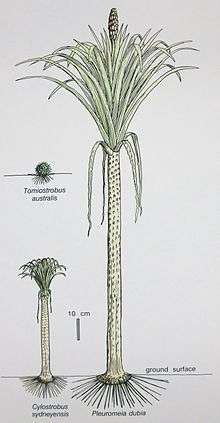Pleuromeiaceae
| Pleuromeiaceae | |
|---|---|
 | |
| Reconstructions of fossils Cylostrobus sydneyensis and Pleuromeia dubia(Pleuromeiaceae) and Tomiostrobus australis (Isoetaceae) from the Early Triassic of the Sydney Basin, NSW, Australia[1] | |
| Scientific classification | |
| Kingdom: | Plantae |
| Division: | Lycopodiophyta |
| Class: | Isoetopsida |
| Order: | Isoetales |
| Family: | Pleuromeiaceae |
| Genera | |
| |
Pleuromeiaceae is an extinct family of plants related to living quillworts (Isoetes), but with tall stems and terminal compact cones. They were especially widespread globally in the aftermath of the Permian Triassic mass extinctions.[2]
References
- ↑ Retallack, Gregory J. (1997). "Earliest Triassic origin of Isoetes and quillwort evolutionary radiation". Journal of Paleontology. 7 (3): 500–521.
- ↑ Retallack, Gregory J. (2013). "Permian and Triassic greenhouse crises". Gondwana Research. 24: 90–103. doi:10.1016/j.gr.2012.03.003.
This article is issued from Wikipedia - version of the 8/5/2016. The text is available under the Creative Commons Attribution/Share Alike but additional terms may apply for the media files.